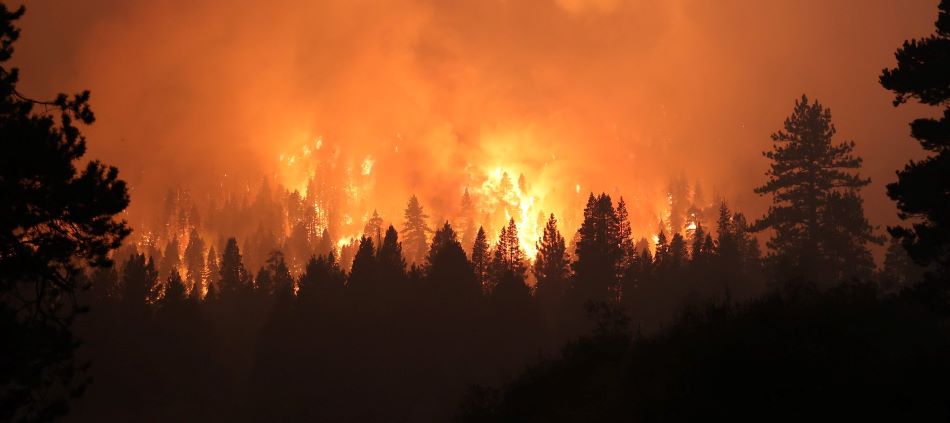By Joanne S. Marchetta 
There comes a moment in a crisis when the things that matter shift. As the Caldor Fire crept its way up the Highway 50 corridor, many of us watched anxiously and worried about the smoke. A few days later when walls of flame had consumed 100,000 acres just outside Tahoe, what mattered was packing irreplaceable photographs, grabbing phone chargers, and checking fuel gauges. As neighborhoods and shopping centers emptied and the rest of the Tahoe Basin took to the edge of their seats, new worries took over too. What will we come back to? Have we done enough to get ready for this day we hoped we’d never have to face?
We are eternally grateful for the heroism, grit, and professionalism of the firefighters and law enforcement officers who faced down the 15th largest fire in California history while we got to safety. In the moment when wildfire arrives, we have no choice but to let go of control. Our communities and our environment are left to firefighters, weather, and fate. But in every moment before fire knocks on our doors, prevention and preparation are the greater form of control. In these times of relentlessly rising temperatures, record drought, and increasingly frequent megafires, tending to our forests and the defense of our homes in the moments before the inevitable next fire is critical.
It is difficult to talk in these terms right now. The Caldor Fire still burns and an extremely dry fire season is still upon us. Many of our neighbors just outside the basin lost their homes in the Caldor Fire and are still displaced. While the immediate focus of the Tahoe Regional Planning Agency (TRPA) will be to assist and support the USDA Forest Service and state and local partners with recovery and repair at Tahoe, we must also keep those crisis-moment worries front and center.
If the 2007 Angora Wildfire was a wakeup call for Lake Tahoe, the Caldor Fire is testing our resilience. In a conflagration like the one that bore down on Tahoe that night, countless factors determine the outcome and experts will be dissecting this fire for some time. The dedicated fire service professionals who fought the fire said that the work that was done to prepare our neighborhoods helped Tahoe dodge a big bullet. Reports from the fire ensure us that hazardous fuels reduction work over the last 14 years made a positive difference, and that defensible space and home hardening helped homes withstand a shower of burning embers. The bottom line is that thousands of homes and businesses in the Tahoe Basin and in neighboring communities were spared and we’re deeply grateful for the fire service professionals who made the stand that saved our beloved lake community.
Following Angora, TRPA joined fire protection districts, the Forest Service, and Nevada and California land managers in forming the Tahoe Fire and Fuels Team (TFFT). Together we have streamlined fuel reduction projects, set policies that encourage defensible space, and worked to secure critical funding to protect communities from wildfire. Since 2007, CalFire and local fire protection districts have conducted 48,500 free defensible space evaluations for private property owners. More than 67,000 acres of initial fuel reduction treatments have been completed around communities, including nearly 10,000 acres of treatments on the south shore near the communities that Caldor threatened. These are among the preparations that contributed to saving the Tahoe Basin from Caldor’s destructive march. And it wouldn’t have been possible without the cooperation and support of our congressional delegation, both states of California and Nevada, and all basin partners.
As Tahoe’s dense, unhealthy forests grow more dangerous with the changing climate, more action is necessary. The multi-agency Lake Tahoe Forest Action Plan calls for basin partners to work at an even larger scale to make our forests more resilient. We need to go further into the forest to improve our odds against fires the size of the Caldor and Dixie fires. The flagship project, the Lake Tahoe West Restoration Partnership, is a 59,000-acre forest resilience project planned for the West Shore. The project can become a model to treat more of Tahoe’s most hazardous areas. Projects like this will require substantially more resources and support from every one of us.
There is continuing hard work ahead of us to grow preparedness. When the next fire comes, how will we fare in that crisis moment? Will we have done enough to protect our communities and the lake itself? In addition to our thanks, we owe it to the fire service professionals to complete the work in front of us to make our forests and communities resilient for the next time.
–Joanne S. Marchetta is the Executive Director of the Tahoe Regional Planning Agency

